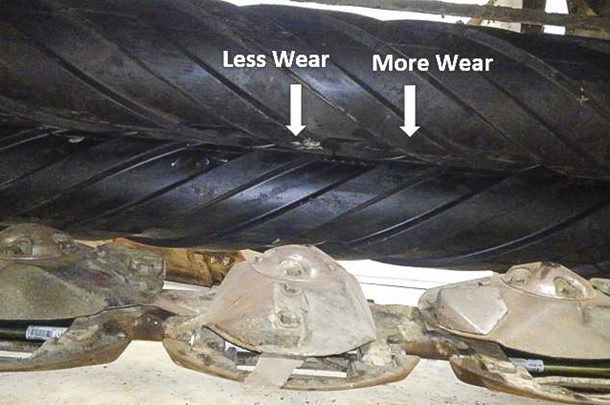The mower conditioner, both rakes and tedder have all been rotating through our shop to be sure they are ready to not only function properly but to make sure hay dries as fast as possible. It is amazing how little adjustments in the shop can save a couple of much-needed hours of drying time. Your operator’s manual will have the proper adjustments for your machine. Just as we always start with the mower for winter repairs, let’s start there on best maintenance practices to improve hay drying.
Mower checklist
Improved hay drying starts at the cutter bar. When the crop is cut ragged with lots of long plant material still attached, this material is often ripped loose by the rake and ends up creating wet spots in windrows. The primary winter service to prevent this is to make sure knives are sharp and not dragging on the cutter bar when spinning. This is also a good time to check all gear boxes and, on disc mower conditioners, that cutting modules are not worn to the point of becoming out of time. Changing cutting speed by slowing down can improve the machine’s ability to cut the entire crop and not leave long stems attached.
This is also the time to check the conditioning system for proper adjustment. Last spring, just before harvest, we checked our mower and found high roll wear that would result in uneven conditioning across the length of the rolls. The area between each cutting module, where more crop runs, had more wear than the center of each module, to the point we could not adjust roll clearance properly.
The rolls are currently missing as we replace them to improve drying. So how do you determine if your rolls need adjustment? First, you will need three pieces of aluminum foil, each 18 inches long. Next, find a 3/8-inch rod at least 18 inches long and roll the aluminum foil around it, creating three 3/8-inch diameter by 18-inch long roll-clearance gauge checkers.
Make sure the mower is lowered to the ground or locked up. Insert the home-made roll gauges into the rolls and turn over by hand until they fall out the back. Roll gauges should be put in the middle and about a foot from each end, or if you can feel wear, put the gauges in both the high and low spots. Once the roll gauges are through the machine, measure the crush points with a digital or dial caliper. The roll clearance for standard rolls should be 1/16 inches to a maximum of 3/32 inches. Measure all crush points on the aluminum foil roll and find the average. Watch for measurements that are out of range over the length of the 18-inch-long roller gauge.
Avoiding tire tracks
Driving over windrows with a tractor tire can greatly affect drying time. For self-propelled swathers, this is not a problem, but for many pull-type mowers, this is a major problem. A standard row crop tire driving on a 9-feet-wide swath slows the drying of 18% of the forage, which will be the limiting factor on when the hay is ready to bale. If soils are damp, not only does air not move through the area that was driven over, but the swath pressed against the ground is pulling moisture from the soil as well. The best solution is to have a tractor set wide enough to straddle your windrows. There are adaptors that will allow you to straddle up to 10 feet. The next best option is to ted windrows soon after mowing so that 18% of your crop does not stay wetter than the rest of the field for 24 hours.
Tedder leveling
Proper tedder maintenance is important so hay is spread evenly over the field, and all hay pressed against the ground is fluffed to allow for better air movement. Untedded hay will now be the drying time limiting factor. When it comes to winter tedder maintenance for drying, the best method is to unfold the tedder on level concrete and check it for levelness across the width of the machine. Many of us do not have level concrete, so another good option is to use a level plywood frame. Just like with the mower, be sure the tractor is off and only turn the machine over by hand when checking distances. When the machine is in the run position, all tines should be the same distance from the ground; 3/4 inches works well for adjustments.
The four most common reasons tedders are not level are bent arms, bent wheel carrier arms, improper tire pressure and replaced tines that are longer than the rest. Most of you are going to cringe as I suggest this, but when replacing tines, they need to be cut to match the length of all the worn tines on your machine. On some of these machines, this may mean the tines will need cut at different lengths; a few machines I know of have a 1/2-inch wear difference between the two tines based on operation angle. These machines have a shorter back tine in the pair compared to the front tine. As larger tedders age, we are seeing the wing pivots wear enough that wings are tipping more than the main frame, causing them to miss hay behind the tractor and add soil to the forage on the wings.
Rake positioning
The last line of defense in our hay-drying system is the rake. The rake’s ability to assist in the drying process is greatly affected by type, adjustments and maintenance. On the maintenance side, just like for tedders, it is important to make sure these machines are level, tines are similar length, spring suspension is not broken and adjustments are correct. Yes, on the leveling side, this means I am suggesting again that you cut tines off to match the worn ones. If you ever replace all tines on the rake, keep a good selection of the used tines as replacements for the future.
While many large producers have gone to rotary rakes, the most common rake in the country is still a parallel bar rake. Most of these have a basket angle adjustment. When this adjustment is in the up position, windrows are fluffier, improving drying, but over time this slot adjustment falls to the bottom or down position, making windrows tighter and slowing drying speed.
May your equipment work well and may you have a safe forage production season this year. ![]()
PHOTO: Uneven roll wear can result in poor conditioning across the length of the rolls. Photo provided by Jason Hartschuh.
Jason Hartschuh is an extension educator for the Crawford County, Ohio State University Extension. Email Jason Hartschuh.












